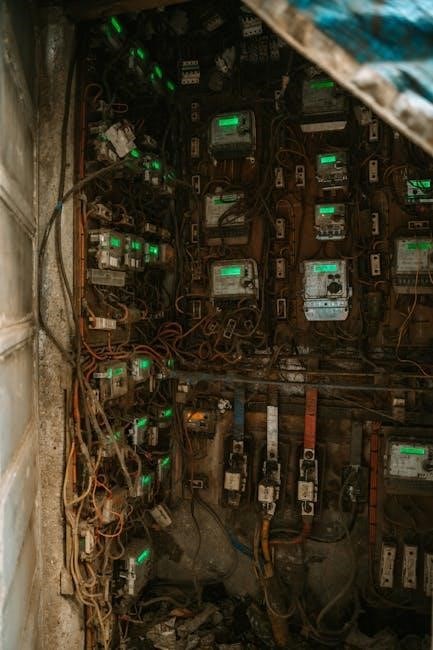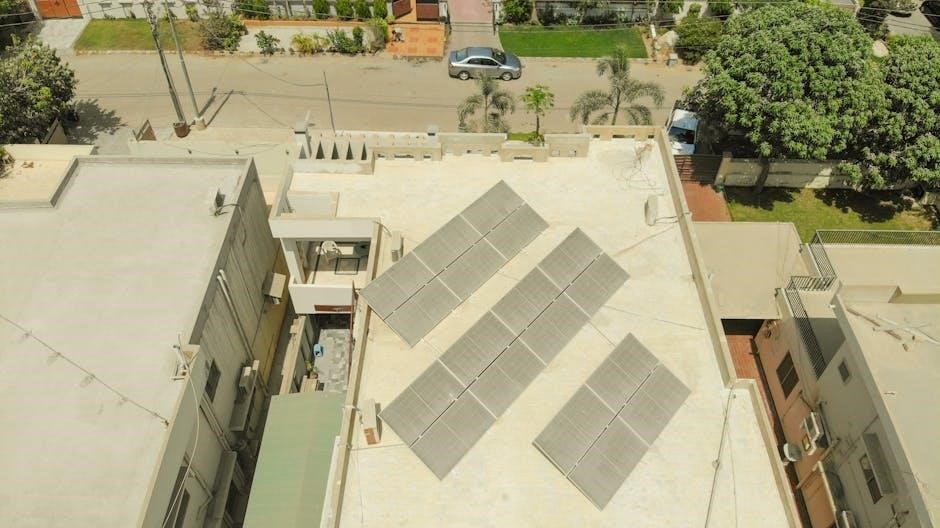schematic solar panel wiring diagram pdf

Understanding Solar Panel Wiring Diagrams
A solar panel wiring diagram is a visual representation․ It details how solar panels connect․ The diagram is crucial for installation․
What is a Solar Panel Wiring Diagram?
A solar panel wiring diagram is a detailed schematic․ It visually illustrates the connections within a solar power system․ This diagram shows how solar panels are interconnected․ It also details connections to other components․ These components include charge controllers‚ batteries‚ and inverters․ The diagrams use standard symbols to represent each element․ This ensures clarity and ease of understanding․ They are essential for planning and executing a safe and efficient solar panel installation․ These diagrams help in troubleshooting issues․ They also aid in system maintenance․ The diagram helps ensure all components are correctly wired․ A proper diagram is essential for optimal performance․ It helps prevent damage to the system․ Having a reliable diagram helps installers and DIY enthusiasts․ It makes the installation process simpler․ Following a diagram ensures correct polarity․ A correct diagram can prevent overloading circuits․ Correct wiring maximizes energy production and system longevity․

Importance of a Schematic Diagram
A schematic diagram is crucial․ It ensures accurate connections․ It aids in troubleshooting and maintenance․ It optimizes performance․
Visual Representation of Connections
A solar panel wiring diagram provides a clear visual representation of how different components in a solar power system are interconnected․ This visual clarity is essential for both initial installation and subsequent maintenance․ The diagram uses symbols and lines to illustrate the connections between solar panels‚ charge controllers‚ batteries‚ inverters‚ and other essential components․ This detailed layout ensures that installers can accurately and safely connect the system‚ minimizing the risk of wiring errors that could lead to system inefficiencies or even safety hazards․ The schematic nature of the diagram allows for a quick and easy understanding of the system’s architecture‚ making it easier to identify potential problems and trace circuits when troubleshooting․ With a well-defined visual guide‚ even those with limited electrical experience can grasp the basic principles of solar panel wiring and ensure the system is functioning correctly․ Moreover‚ the diagram serves as a valuable reference point for future modifications or expansions to the solar power system‚ ensuring that any changes are implemented in a safe and effective manner․ This visual aid is indispensable for achieving a reliable and efficient solar energy setup․
Troubleshooting and Maintenance Aid
A schematic diagram is an invaluable tool for troubleshooting and maintaining a solar panel system․ When issues arise‚ such as reduced power output or system failure‚ the diagram serves as a roadmap for identifying the source of the problem․ Technicians can use the diagram to trace circuits‚ check connections‚ and verify the proper functioning of each component․ This systematic approach can significantly reduce the time required to diagnose and repair faults․ The diagram also aids in preventative maintenance by allowing technicians to easily inspect wiring and connections for signs of wear‚ corrosion‚ or damage․ By regularly comparing the actual system configuration with the schematic‚ potential problems can be identified and addressed before they escalate into more serious issues․ This proactive approach can extend the lifespan of the solar panel system and ensure its continued efficient operation․ Furthermore‚ the diagram can be used to document any modifications or repairs made to the system‚ creating a comprehensive maintenance record that can be used for future reference․ With a clear and accurate schematic‚ troubleshooting and maintenance become more efficient‚ safer‚ and ultimately more cost-effective‚ ensuring the long-term reliability of the solar power system․

Key Components in a Solar Panel Wiring Diagram
A wiring diagram details essential parts․ These include solar panels‚ charge controllers‚ batteries‚ and inverters․
Solar Panels
Solar panels‚ also known as photovoltaic (PV) modules‚ are the fundamental building blocks of any solar power system․ They convert sunlight into direct current (DC) electricity․ In a wiring diagram‚ solar panels are typically represented as rectangles with positive (+) and negative (-) terminals․ The diagram indicates how multiple panels are connected together to achieve the desired voltage and current output for the system․ The number of panels‚ their voltage ratings‚ and their current ratings are critical factors in determining the overall system configuration․ Wiring diagrams often specify the panel model and its electrical characteristics‚ ensuring compatibility and optimal performance․ Understanding how solar panels are depicted in a wiring diagram is essential for planning and installing a solar energy system correctly․ Correct wiring ensures efficient energy conversion and prevents potential damage to the system components․ Solar panel placement and orientation are also indirectly influenced by the wiring diagram as it dictates string configuration and overall array layout․
Charge Controller
A charge controller‚ often referred to as a solar charge controller or battery charge controller‚ is a vital component in a solar panel system․ Its primary function is to regulate the voltage and current flowing from the solar panels to the batteries‚ preventing overcharging and extending battery life․ In a wiring diagram‚ the charge controller is usually depicted as a box or a similar symbol with connections for the solar panels‚ the battery bank‚ and sometimes a load․ The diagram specifies the charge controller’s input voltage and current ratings‚ as well as its output characteristics․ Different types of charge controllers‚ such as PWM (Pulse Width Modulation) and MPPT (Maximum Power Point Tracking)‚ are chosen based on the system’s voltage‚ current‚ and battery type․ MPPT controllers are more efficient as they optimize the power transfer from the solar panels to the batteries․ The wiring diagram clearly shows how the charge controller is connected in the circuit‚ ensuring proper polarity and preventing reverse current flow․ Correctly installing the charge controller‚ according to the wiring diagram‚ ensures safe and efficient battery charging‚ maximizing the lifespan and performance of the entire solar energy system․
Battery Bank
The battery bank serves as the energy storage component in a solar power system‚ accumulating the direct current (DC) electricity generated by the solar panels via the charge controller․ A solar panel wiring diagram illustrates how batteries are connected‚ either in series‚ parallel‚ or a combination of both‚ to achieve the desired voltage and capacity․ Batteries in series increase the overall voltage while maintaining the same amp-hour capacity‚ whereas parallel connections maintain the voltage but increase the amp-hour capacity․ The wiring diagram specifies the number of batteries‚ their individual voltage and amp-hour ratings‚ and the connection configuration․ Proper wiring ensures the battery bank operates efficiently and safely․ The diagram includes details on fuses or circuit breakers to protect against overcurrent and short circuits․ It also indicates the correct polarity for each connection‚ preventing damage to the batteries or other system components․ Different battery types‚ such as lead-acid‚ lithium-ion‚ or AGM‚ require specific charging parameters‚ so the wiring must comply with the manufacturer’s recommendations․ A clear and accurate representation of the battery bank wiring is essential for both installation and troubleshooting‚ ensuring the system’s reliability and longevity․ Additionally‚ the diagram may include grounding information‚ further enhancing safety and preventing electrical hazards․
Inverter
The inverter is a critical component in a solar power system‚ responsible for converting the direct current (DC) electricity produced by the solar panels and stored in the battery bank into alternating current (AC) electricity․ This AC electricity is what most household appliances and electrical grids utilize․ A solar panel wiring diagram clearly shows the inverter’s connection to the battery bank and the AC distribution panel․ The diagram specifies the inverter’s input voltage range‚ output voltage‚ and power rating‚ ensuring it matches the system’s requirements and capacity․ The wiring diagram includes the size and type of wiring needed to handle the current flow between the battery bank and the inverter‚ as well as appropriate overcurrent protection devices like fuses or circuit breakers․ Grounding connections are also illustrated to ensure safety and prevent electrical shock hazards․ In some systems‚ the inverter may also have grid-tie capabilities‚ allowing excess solar power to be fed back into the utility grid․ The wiring diagram will indicate the necessary connections and safety measures for grid-tie operation‚ including disconnect switches and compliance with local electrical codes․ Furthermore‚ the diagram might depict any communication cables used for monitoring the inverter’s performance or integrating it with other smart home systems․ A well-defined inverter wiring section in the solar panel diagram guarantees proper installation and operation‚ maximizing the system’s efficiency and reliability․

Series vs․ Parallel Wiring Configurations
Solar panel wiring uses series and parallel setups․ Series boosts voltage‚ while parallel increases current in the system․
Series Wiring
Series wiring involves connecting solar panels end-to-end‚ linking the positive terminal of one panel to the negative terminal of the next․ This configuration increases the overall voltage of the solar array while maintaining the same current․ The total voltage is the sum of the individual panel voltages․ Series connections are suitable when a higher voltage is needed to match the input requirements of the charge controller or inverter․ However‚ if one panel in the series string is shaded or malfunctions‚ it can significantly reduce the output of the entire string‚ as the current is limited by the weakest panel․ Therefore‚ it is crucial to ensure all panels in a series string receive equal sunlight and are in good working condition․ Proper wiring and secure connections are also essential to prevent voltage drops and ensure efficient energy transfer․ Consider using appropriately sized wiring and connectors to handle the increased voltage․ Regular inspections of the series connections are recommended to identify and address any potential issues that may arise over time‚ such as loose connections or corrosion; Implementing bypass diodes can also help mitigate the impact of shading or panel failure on the overall system performance by allowing current to flow around the affected panel․
Parallel Wiring
Parallel wiring connects solar panels side-by-side‚ linking all positive terminals together and all negative terminals together․ This configuration increases the overall current of the solar array while maintaining the same voltage as a single panel․ The total current is the sum of the individual panel currents․ Parallel connections are beneficial when a higher current is needed to charge batteries or power devices with specific current requirements․ Unlike series wiring‚ if one panel in a parallel string is shaded or malfunctions‚ it does not significantly affect the output of the other panels‚ as the current can still flow through the remaining panels․ However‚ it’s crucial to use appropriately sized wiring and fuses to handle the increased current and prevent overloading the circuit․ Proper grounding is also essential to ensure safety and prevent electrical hazards․ When wiring panels in parallel‚ use a combiner box to simplify the connections and provide overcurrent protection for each string of panels․ Regular inspections of the parallel connections are recommended to identify and address any potential issues that may arise over time‚ such as loose connections or corrosion․ Consider using blocking diodes to prevent reverse current flow from the battery back to the solar panels at night‚ which can drain the battery․ Maintaining consistent voltage levels across all panels in the parallel array is also important for optimal performance;

Downloading and Interpreting PDF Diagrams
Accessing and understanding PDF diagrams are essential․ They provide detailed schematics for solar panel wiring setups․
Finding Reliable PDF Resources
Locating trustworthy PDF resources is vital for accurate solar panel wiring․ Begin by checking the manufacturer’s website for your specific solar panel model․ Manufacturers often provide detailed wiring diagrams and installation guides as PDFs․ These are usually the most reliable sources‚ tailored to their products․ Search for reputable solar energy websites‚ forums‚ and online communities known for their expertise․ These platforms often host user-submitted diagrams or links to reliable resources․ Look for diagrams that are clear‚ well-labeled‚ and include all necessary components‚ such as solar panels‚ charge controllers‚ batteries‚ and inverters․ Ensure the diagrams match your system’s voltage and configuration (series‚ parallel‚ or series-parallel)․ Cross-reference information from multiple sources to confirm accuracy․ Be wary of generic diagrams that may not apply to your specific setup․ Always prioritize resources from certified solar installers or electrical engineers․ Verify the diagram’s source and date to ensure it is up-to-date and compliant with current electrical codes and safety standards․ A reliable PDF resource will significantly reduce the risk of wiring errors and ensure the safe and efficient operation of your solar panel system․ Consider downloading examples from trusted sources․
Understanding Symbols and Conventions
Interpreting solar panel wiring diagrams requires familiarity with common symbols and conventions․ Solar panels are typically represented by a rectangle with diagonal lines or a stylized depiction of photovoltaic cells․ Wires are shown as solid lines‚ indicating electrical connections․ Positive (+) and negative (-) symbols denote polarity‚ crucial for correct wiring․ Grounding is often indicated by a three-tiered downward-pointing symbol․ Circuit breakers are depicted as a rectangle with a switch inside‚ while fuses are shown as a line with a break in the middle․ Batteries are represented by a series of short and long parallel lines‚ with the longer line indicating the positive terminal․ Inverters‚ charge controllers‚ and other components have their own distinct symbols‚ usually labeled for clarity․ Dashed lines may indicate alternative wiring options or connections that are not always present․ Wire gauges are often specified next to the wire lines‚ indicating the appropriate wire size for the current․ Voltage and amperage ratings for each component are typically included to ensure proper matching and prevent overloading․ Diagrams often use color coding‚ with red usually indicating positive wires and black indicating negative wires․ Refer to the diagram’s legend or key to understand any specific symbols or conventions used․ A thorough understanding of these symbols is essential for accurately interpreting and implementing the wiring diagram‚ ensuring a safe and functional solar panel system․
Common Wiring Mistakes to Avoid
Safety Precautions When Working with Solar Panel Wiring
Prioritize safety․ Always disconnect power sources before wiring․ Use proper tools․ Ensure correct polarity to prevent damage․



Leave a Reply
You must be logged in to post a comment.